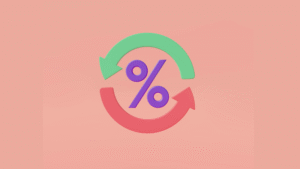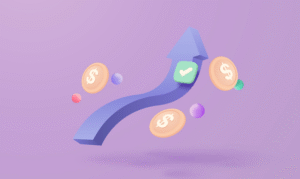What is the conversion rate, and why does it matter?
What is the conversion rate: Conversion rate refers to the percentage of website or app visitors who complete a desired action or goal, such as purchasing, filling out a form, or subscribing to a service. Conversion rate measures the success of a website or marketing campaign in converting visitors into customers or achieving specific goals. In simple terms, the conversion rate records the percentage of users who complete your desired goal.
How to calculate the conversion rate
Conversion rate is the ratio of two data points to each other (the ratio of the number of site conversions to the total number of visitors), expressed as a percentage. Conversion rate is calculated and measured by taking the total number of users who “convert” their visit into something monetized (for example, by clicking on an ad), dividing it by the total number of audiences (visitors), and finally converting the resulting figure to a percentage.
The conversion rate calculation is as follows:
100 X [ Total number of visitors ÷ Number of conversions divided by number of desired actions]

Now, let’s understand the conversion rate calculation better with two examples:
If a website has 1000 visitors and 100 of them purchase from the site, the conversion rate calculation is as follows:
(100 / 1000) x 100 = 10%
This means that of every 100 visitors, 10 convert into customers.
You hire a digital marketing expert to design an advertising campaign. He runs this campaign with a specific number of audiences. Out of the 20,000 audience, 800 people clicked on the ad (i.e., converted). The conversion rate calculation for this example is as follows:
(800 / 20,000) x 100 = 4%
This means that of every 100 visitors, four click on the ad.

Why is the conversion rate significant?
Conversion rate is a key performance indicator for businesses’ data-driven decision-making. Companies can identify the most effective marketing channels by comparing conversion rates across channels or campaigns and allocate resources accordingly. This helps identify successful tactics and improve poorly performing tactics, resulting in higher conversion rates and overall business growth.
Conversion rate helps businesses evaluate the performance of their sales funnel, advertising campaigns, and user experience. By tracking and analyzing conversion rates, companies can identify areas for improvement to optimize their marketing strategies and improve the performance of their website or app. For example, if the conversion rate is low, there may be issues with UX design, the checkout process, or content relevance. On the other hand, increasing conversion rates can lead to higher revenue, customer acquisition, and return on investment (ROI).
If we were to list the importance of conversion rates in business, we could consider the following list:
Calculating marketing success
Identifying opportunities for improvement
Maximizing budget utilization
Understanding the customer journey map
Professionally tracking site performance progress
Building customer trust in your brand
Benefits of Conversion Rates
Now that we know the importance of conversion rates, let’s learn more about the benefits and positive points that using conversion rates correctly and well can bring to businesses! Here are 6 of the most essential benefits of conversion rates:
Increased sales: The higher the conversion rate, the more customers will buy directly, increasing revenue.
Cost-effectiveness: By optimizing your conversion rate (which we will explain below), you can reduce your marketing costs and generate more sales without wasting resources on ineffective strategies.
Higher return on investment (ROI): By improving your conversion rate, your marketing efforts will become more valuable, resulting in higher ROI and profitability.
Competitive advantage: A higher conversion rate means you can outperform your competitors, attract more customers, and strengthen your position in the market.
Sustainable Growth: By continuously optimizing your marketing efforts, continuous improvement in conversion rates helps you achieve long-term growth.
Improved Customer Experience: Focusing on conversion rates encourages businesses to understand their customers better, which leads to improved website design, user experience, and overall customer satisfaction.
What is conversion rate optimization?
Conversion rate optimization (CRO) involves improving the percentage of website visitors or users who complete a desired action. This action can include purchasing, filling out a form, subscribing to a newsletter, or any other goal the business defines. The main goal of CRO is to maximize the effectiveness and efficiency of a website or landing page to increase conversion rates and ultimately increase the business’s revenue and profits.
Conversion rate optimization (CRO) typically involves analyzing data, conducting experiments, and improving a website, app, or… to encourage more visitors to complete a specific goal. CRO focuses on identifying and removing obstacles that prevent visitors from taking the desired actions. It aims to improve the website’s overall performance and profitability, driving business growth.

7Effective Ways to Optimize Conversion Rate (CRO)
1) A/B Testing
This technique involves creating two or more variations of a web page or element and splitting traffic equally between them to measure which version results in higher conversions. By comparing the performance of each variation, businesses can identify the most effective design or content elements and work towards improving them.
2) Improving User Experience (UX)
Analyzing and improving the user experience on a website can significantly impact conversion rates. This can be achieved through various methods, including simplifying navigation, reducing page load times, improving the usability of the website or app on mobile, creating visual forms, and ensuring a consistent brand identity across the website.
3) Landing Page Optimization
Focusing on improving the effectiveness of specific landing pages can increase conversions. This includes optimizing headlines, copywriting, setting relevant calls-to-action, designing visual elements to align with user expectations, and providing a clear and compelling value proposition. In short, you need to ensure that when a user or visitor lands on your website, they know what you do, what the benefits of purchasing your product or service are, and are willing to spend time on your site to do something.
4) Customer Journey Analysis
Understanding the customer journey from the initial visit to the final conversion can be key to optimizing conversion rates. Examining the different touchpoints and stages of a customer journey map allows businesses to identify potential areas of friction or drop-off where conversions are being lost. Addressing these issues and providing a seamless customer experience can improve conversion rates.
5) Personalization and Targeting
Tailoring the website experience for each user based on their preferences, behaviors, or demographics can increase their engagement and, consequently, conversions. Implementing personalized recommendations, dynamic content, and targeted messaging can create a more relevant and engaging experience for each user. For example, if your product A buyers are mostly teenagers, you can design the page to be more appealing to them.
6) Social Proof and Building Trust
Adding social proof sections like customer testimonials, reviews, ratings, and security and trust badges like InMod can increase visitor trust and credibility, ultimately leading to higher conversion rates. Highlighting positive feedback and showing off any certifications or badges you’ve received can ease user concerns and encourage them to convert.
7) Clear and Compelling Calls-to-Action (CTAs)
Optimizing the design, placement, and messaging of CTA can significantly impact conversion rates. CTAs should be visually striking, use compelling language, and clearly and step-by-step outline users’ steps to achieve their desired outcome.
Conclusion
Overall, conversion rate optimization requires a data-driven approach, continuous analysis, testing, and a deep understanding of user behavior to implement effective strategies that encourage users to “convert” and grow your business.